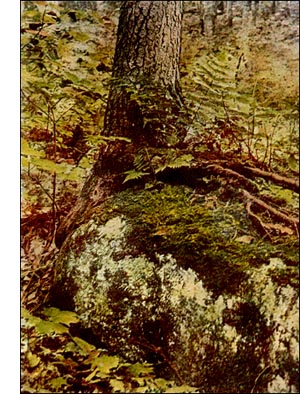Brachythecium Novae Angliae Moss
 Novae-Angliae, (Cull. & Lesq.) Jaeger & Sauer.
Novae-Angliae, (Cull. & Lesq.) Jaeger & Sauer.Habit and habitat.-On earth and stones.
Name.-The specific name is the Latin for "New England."
Plant (gametophyte).-Forming loosely entangled mats; stem 1I to 2 inches long, irregular; branches cylindrical, with rather short, overlapping, slightly spreading leaves.
Leaves.-Erect, spreading, sometimes very concave, not plaited, not glossy, incurved, broadly ovate,narrowly taper-pointed; base growing down the stem; decurrent; vein reaching the middle: margin finely saw-toothed all around; cells narrowly oblonghexagonal, shorter and broader at the basilar angles.
Leaves at the base of the pedicel.-Ovate, long, taper-pointed, recurved from the middle; vein not easily distinguishable.
Habit of flowering.-Male and female flowers on separate plants.
Perichaetial leaves (dioicous).
Veil (calyptra).-Thin, split up one side.
Spore-case.-Oblong, erect, slightly curved.
Pedicel (seta).-Rough, purple.
Lid (operculum).-Long, conical, taper-pointed.
Annulus.-Double, large.
Teeth (peristome).-Teeth densery articulate, segments of the inner membrane as long as the teeth. Cilia well developed but without transverse spurs attached at intervals to the margin.
Spores.-Mature in late fall and early spring.
Distribution.--Northeastern United States and Canada.